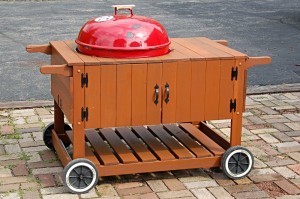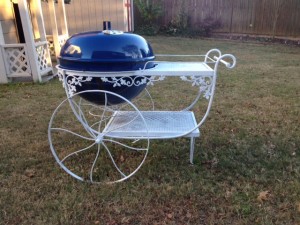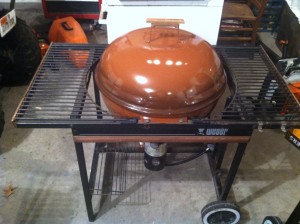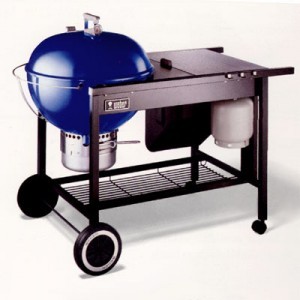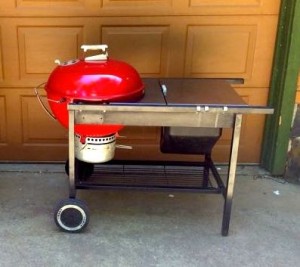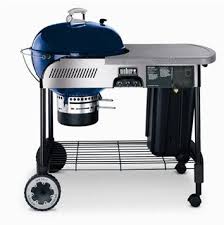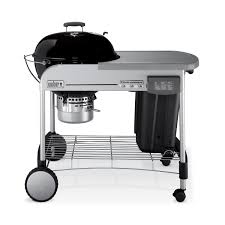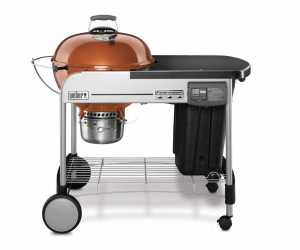Those of us who have spent some time with a grill know that there is a constant need for a table close by. Whether it’s staging food about to be cooked, a place for spices and condiments, or a surface to set down those perfectly cooked steaks right off the grill, a table is almost a necessity for efficient grilling. Very early on in its history, the Weber-Stephen company recognized the need as well and began to offer both accessories and integrated grills that would eventually lead to one of their finest offerings, the Weber Performer.
Early Days 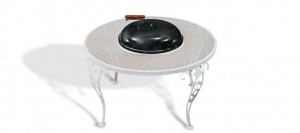 – Perhaps the earliest version of a Weber grill integrated with a table is the Flamenco. First introduced in 1963, the kettle in a table was designed with the idea that people could sit around a table and grill hors d’oeuvres or small cuts of meat while enjoying the company of friends. It was an attempt to show consumers a new way to entertain before the main meal was served.
– Perhaps the earliest version of a Weber grill integrated with a table is the Flamenco. First introduced in 1963, the kettle in a table was designed with the idea that people could sit around a table and grill hors d’oeuvres or small cuts of meat while enjoying the company of friends. It was an attempt to show consumers a new way to entertain before the main meal was served.
By 1968, Weber introduced two new models with an integrated table and wheels; the Seville and the Imperial Sequoia. Both models used the popular 22.5 inch kettle integrated into a purpose-built cart. The Seville was made of iron and the Sequoia was built with wood to complement the styles of America’s patio furniture at the time. Both models offered space next to the grill for staging, storage for tools, and wheels to facilitate easy movement of the grills. The seeds of what would become the Performer model were now planted.
Transition Kettle – The earliest Performer-style kettle was not a charcoal kettle at all! In the mid 80’s, Weber produced this kettle which had gas burners, but retained the classic Weber kettle shape. Weber model 61101 featured a kettle that was integrated into a cart. The cart provided workspace on either side of the kettle and the bowl of the kettle is mounted to the frame with two tabs permanently attached to the kettle bowl. This design feature would carry over into subsequent generations of Performers. Not shown in the photo is the 5 gallon propane tank that hung from the right side of the cart. The 1986 issue of Consumer Reports rated the Weber 61101 as “Not Acceptable” due to dangers associated with ignition failure and subsequent propane build up leading to possible “flash of flame” and further warned current owners to remove the ignitor and only light the burner with a long match.
Four Patents, One Kettle – The first model of the Weber Charcoal Performer was introduced in 1990. To fully understand its beginnings, it is necessary to get some background on the company’s patent applications at the time. The Performer is the result of three patent applications filed in August, 1990 which combined, formed the fourth patent which became the essence of the new model. Some Weber patent background:
US Patent 5,027,788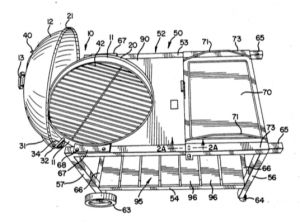 Barbecue kettle cart, issued July 2, 1991. Perhaps the most meaningful of the three patents, this one provides for a cart: “This patent takes the kettle off of the tripod and into the cart. The cart offered the advantages of a built in work table that could slide away to reveal an integrated storage bin. The cart structure provided a frame for a bottom rack that could store more material”.
Barbecue kettle cart, issued July 2, 1991. Perhaps the most meaningful of the three patents, this one provides for a cart: “This patent takes the kettle off of the tripod and into the cart. The cart offered the advantages of a built in work table that could slide away to reveal an integrated storage bin. The cart structure provided a frame for a bottom rack that could store more material”.
US Patent 5,036,832 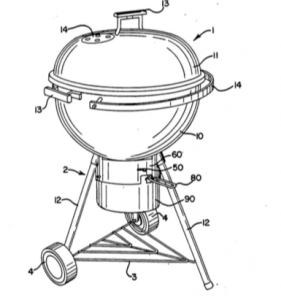 Ash catcher assembly for barbecue grill, issued August 6, 1991. This patent introduced the cylindrical ash catcher that is now on both the Performer and the One Touch Gold grills: “An ash catcher assembly is developed which can catch ash and debris falling out through openings in the bottom of the barbecue kettle. It is also very easy to assemble and empty. Further, the ash catcher can be easily retrofitted onto previously made kettle grills. And, the present assembly can be easily disassembled to clean and store“.
Ash catcher assembly for barbecue grill, issued August 6, 1991. This patent introduced the cylindrical ash catcher that is now on both the Performer and the One Touch Gold grills: “An ash catcher assembly is developed which can catch ash and debris falling out through openings in the bottom of the barbecue kettle. It is also very easy to assemble and empty. Further, the ash catcher can be easily retrofitted onto previously made kettle grills. And, the present assembly can be easily disassembled to clean and store“.
US Patent 5,213,075 Igniter for charcoal grill, issued May 25, 1993. Weber was using propane burner tubes for its Genesis series of grills by this time. This patent utilizes the idea of a burner tube to ignite charcoal: “A gas burner for a charcoal grill having a bowl includes an elongated burner tube secured to the bowl and passed through an opening in the bowl so as to be positioned in a substantially horizontal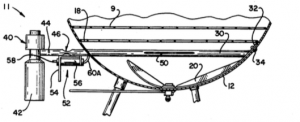 manner below and substantially parallel to a bed of charcoal supported on a charcoal support grid. The burner has a propane tank connected to the free end thereof outside the bowl and has air intake openings in the tube adjacent the free end. A venturi section is formed into the tube downstream of the air intake openings and elongated diametrically-opposed, horizontal slots defining the gas exit ports are positioned downstream of the venturi section. An igniter assembly having its electrode extending through an opening into the tube is located between the venturi section and the slots to ignite the flowing gases. The positioning of the electrode within the tube prevents flash-back through the air intake openings”.
manner below and substantially parallel to a bed of charcoal supported on a charcoal support grid. The burner has a propane tank connected to the free end thereof outside the bowl and has air intake openings in the tube adjacent the free end. A venturi section is formed into the tube downstream of the air intake openings and elongated diametrically-opposed, horizontal slots defining the gas exit ports are positioned downstream of the venturi section. An igniter assembly having its electrode extending through an opening into the tube is located between the venturi section and the slots to ignite the flowing gases. The positioning of the electrode within the tube prevents flash-back through the air intake openings”.
US Patent 5,076,252 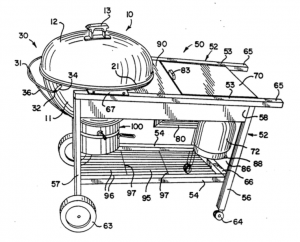 Barbecue grill assembly, issued Dec 31, 1991. In this patent, all three concepts were combined to describe the first Weber Performer Grill: “According to the present invention a portable barbecue grill assembly is disclosed that includes a barbecue kettle that has a generally semi-hemispherical bottom bowl and a generally semi-hemispherical removable kettle cover with an ash catcher and a kettle cover holder secured to the bottom bowl, a storage bin with a bin cover, a fuel tank, a gas ignitor secured to the bottom bowl for igniting the fuel flowing from the fuel tank into the bowl, and an improved cart structure for supporting each of these components at a working and an accessible height. The bottom kettle bowl is supported adjacent one end, and the storage bin, the bin cover, the fuel tank, and the ignition controls are supported adjacent the other end.”
Barbecue grill assembly, issued Dec 31, 1991. In this patent, all three concepts were combined to describe the first Weber Performer Grill: “According to the present invention a portable barbecue grill assembly is disclosed that includes a barbecue kettle that has a generally semi-hemispherical bottom bowl and a generally semi-hemispherical removable kettle cover with an ash catcher and a kettle cover holder secured to the bottom bowl, a storage bin with a bin cover, a fuel tank, a gas ignitor secured to the bottom bowl for igniting the fuel flowing from the fuel tank into the bowl, and an improved cart structure for supporting each of these components at a working and an accessible height. The bottom kettle bowl is supported adjacent one end, and the storage bin, the bin cover, the fuel tank, and the ignition controls are supported adjacent the other end.”
The Generations of Weber’s Performer
Gen 1 –The first Performer, introduced in 1990, is often referred to as the stainless steel or “SS” Performer. The top surfaces surrounding the kettle and the adjacent “flip up” horizontal surface were made of stainless steel. The early SS models came in two basic variants; a gas-assist version that had the propane tank and burner tube for lighting charcoal, and a non gas-assist model that eliminated these features. Interestingly, the gas-assist version had wheels on the left legs of the cart and castors on the right legs while the non-gas assist model only had wheels on the left legs. Its right legs were longer and did not include the castors. Both versions had a plastic charcoal bin underneath the table for storing fuel and a wire storage area at the bottom of the cart for miscellaneous storage. The SS performers came with 3 metal clips that attached to the top rail for hanging grill brushes, spatulas, and other grilling tools. Like the Master Touch models of the same era, the SS performer had an integrated, removable thermometer located in the lid handle. Colors offered in Gen 1 include Black, Red, Red Mist, Dark Green, Dark Blue, Plum, and Grey.
Gen 2 – 2005 The first revision of the Weber Performer happened a full 15 years after the SS Performer was introduced. One of the biggest improvements was to raise the height of the grill and the table by a few inches to make it more comfortable to use. While improving functionality, Weber was clearly looking to reduce its costs associated with this model as well. Square steel stock for the frame was replaced by lighter gauge metal tubing, the 5 gallon propane tank was replaced by fittings that allowed for disposable propane canisters, and the stainless steel top was replaced by a fiberglass reinforced plastic table. The new table was bolted to the frame and no longer contained the “flip up” feature of the previous Performer. Consequently, the design for the plastic charcoal bin was changed to a “tip out” design. The grill tool hooks were now integrated into the cart, the ash bucket was now black, and the wheel design was changed. Colors offered in Gen 2 include Black, Dark Green, Grass Green (Crate and Barrel offering), Dark Blue, Sage, and Grey.
Gen 3 – 2010 The third generation of the Performer incorporated minor changes to Gen 2. The thermometer used to measure kettle temperature was removed from the handle and integrated into the lid of the kettle. Other changes were primarily cosmetic; the grill tool hooks were no longer recessed, the wheel style was changed to full “hubcaps” with the Weber logo, the ash bucket and frame tubing were changed back to silver, and the bottom rack was redesigned to include an arch. For 2014, electronic ignition started to appear in the igniter assembly. Colors for Gen 3 include Black, Dark Green, Grass Green (Crate and Barrel offering), Dark Blue, Red Brick, Crimson, and Copper (2014 only).
Gen 4 – 2015 (Performer deluxe) With the fourth generation of the Performer, it is clear that Weber has been listening to the feedback of its customers and using that input to provide significant improvements in this model’s design. The plastic table of the Gen 2 and Gen 3 Performer was replaced with a hammer tone metal unit, increasing durability and more importantly, providing a much easier surface to keep clean. The lid bale clearance was increased by 2″ to provide much better access to the grill while the lid is stored. In a move that has certainly created controversy across the WKC, Weber replaced the integrated kettle lid handle with a bolt on unit that sits higher and contains a heat shield. The ash bucket is a new design with a tapered bottom and a squeeze handle to facilitate easier removal and replacement while dumping ashes. Behind the grey door in the frame is a removable cook timer and the ignition knob for the gas assist feature. The ignition is now an electronic unit that enables multiple, rapid fire sparks for better ignition. Colors for Gen 4 include Black, Dark Green, Copper, Crimson (Ace Hardware offering), and Dark Blue (Crate and Barrel offering).
The Weber Performer, with its integrated table, gas assist, and charcoal storage, is an excellent example of a design that provides all the capabilities of a Weber charcoal kettle with additional features to make grilling a true pleasure. The Performer has always been priced at the top of Weber’s kettle lineup and is considered a premium model. Though the years, this model has evolved and continues to improve, with the 2015 Gen 4 considered by many to be the best Performer ever.
A timeline, gallery, and repository for information regarding the Weber Performer kettle is an ongoing effort of the WKC. If you have something you would like to share, please feel free to send a message to WKC member “Winz”.

